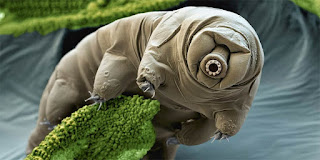Yes, this is a real animal. In fact, it is nature's most indestructible animal! Only the eventual death of the sun may be enough to wipe out the Tardigrade.
But first, what is the Tardigrade?
Also known as water bears, the Tardigrade are water-dwelling, eight-legged micro-animals. When fully grown, they are about .02 inches long. Each foot has 4 to 8 claws each. The mouth has small stylets, which are used to piece plant cells, algae, or small invertebrates on which they feed. (Glad they don't eat humans!)
They have been found everywhere - from mountaintops to the deep sea and mud volcanoes, and from tropical rain forests to the extreme temperatures of the Antarctic. Which leads to the question...
How are Tardigrades indestructible?
They can survive 30 years without food.
They can live in volcanoes and withstand the intense pressures of the deep ocean.
They can survive from -328 to +300 degrees Fahrenheit!
They can even endure the deep vacuum of space. Researches even believe they could survive an asteroid impact, like the one believed to spell the doom of dinosaurs. In fact, scientists estimate that Tardigrades have been around for 600 million years!
Yes, but HOW can all of this be possible?
Tardigrades of indestructible due to something called Cryptobiosis, which literally means "hidden life." Cryptobiosis is a form of suspended animation in which organisms can go on living even as they look dead. So when times get tough, Tardigrades play dead. They hunch up into little dried husks and more or less shut down, which drops their metabolisms to 0.01% of their usual rate. The Waterbear enters cryptobiosis by contracting its body into something called a tun, whereby it loses more than 95% of its free and stored water; essentially, it dehydrates itself. In this state, the Waterbear creates different proteins and sugars that help protect its cells. Once these cell protectants are synthesized, the Tardigrade reduces, and at times suspends, its metabolism. When conditions improve within the environment, the Tardigrade activates its metabolism once again, aided by hydration from water intake. It, essentially reanimates itself.
So. Amazing.
